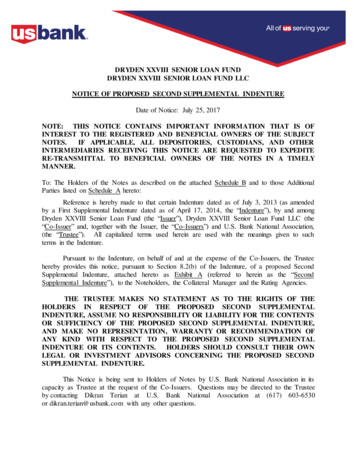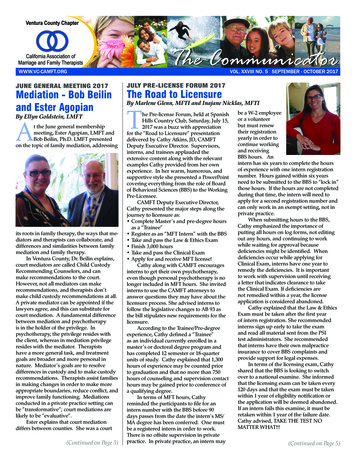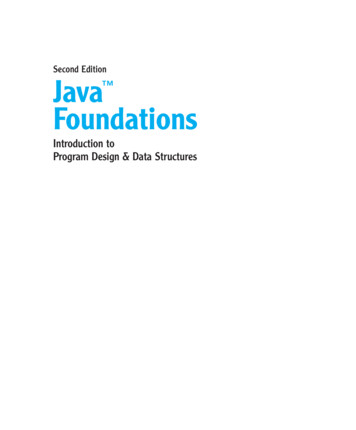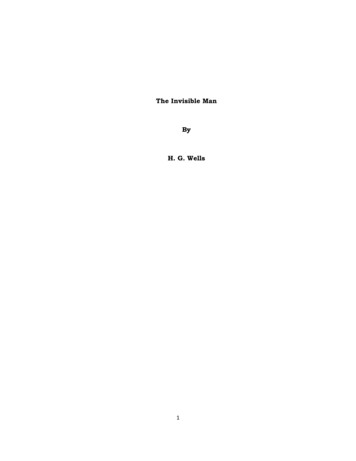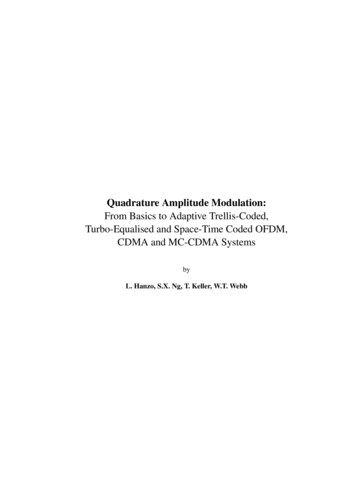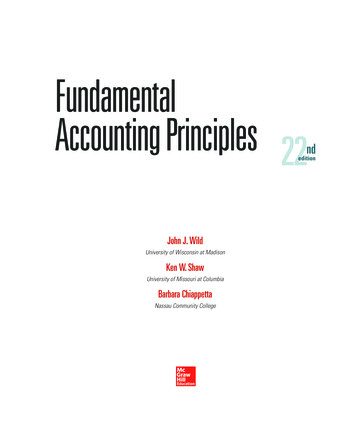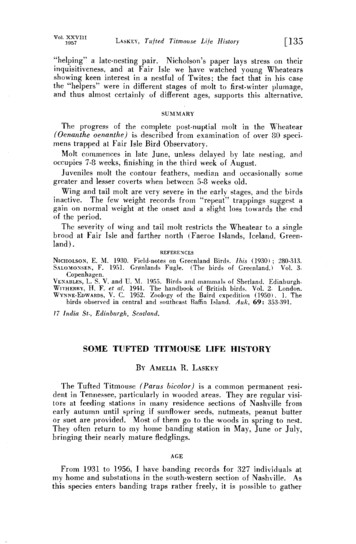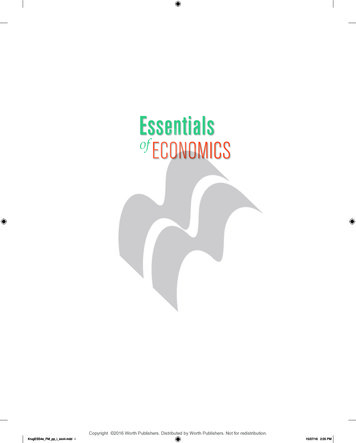
Transcription
EssentialsofECONOMICSCopyright 2016 Worth Publishers. Distributed by Worth Publishers. Not for redistribution.KrugESS4e FM pp i xxviii.indd i15/07/16 2:05 PM
Copyright 2016 Worth Publishers. Distributed by Worth Publishers. Not for redistribution.KrugESS4e FM pp i xxviii.indd ii15/07/16 2:05 PM
EssentialsofECONOMICSFOURTH EDITIONPaul KrugmanGraduate Center of the City University of New YorkRobin WellsNew YorkCopyright 2016 Worth Publishers. Distributed by Worth Publishers. Not for redistribution.KrugESS4e FM pp i xxviii.indd iii15/07/16 2:05 PM
To beginning students everywhere, which we all were at one time.Vice President, Social Science: Charles LinsmeierPublisher: Shani FisherMarketing Manager: Tom DigianoMarketing Assistant: Morgan RatnerExecutive Development Editor: Sharon BalbosConsultant: Ryan HerzogSenior Media Editor: Lukia KliossisEditorial Assistant: Courtney LindwallDirector, Content Management Enhancement: Tracey KuehnManaging Editor: Lisa KinneProject Editor: Martha EmryDirector of Design, Content Management: Diana BlumeInterior and Cover Designer: Vicki TomaselliPhoto Editor: Cecilia VarasPhoto Researchers: Elyse Rieder and Cecilia VarasSenior Production Supervisor: Stacey B. AlexanderSenior Media Producer: Chris EfstratiouMedia Producers: Andrew Vaccaro and Daniel ComstockComposition and Illustrations: MPS Ltd.Printing and Binding: RR DonnelleySee page xxv for cover credits information. Page xxv is an extension of this copyright page.ISBN-13: 978-1-4641-8665-3ISBN-10: 1-4641-8665-0Library of Congress Control Number: 2016936479 2017, 2014, 2011, 2007 by Worth PublishersAll rights reserved.Printed in the United States of AmericaFirst printingWorth PublishersOne New York PlazaSuite 4500New York, NY 10004-1562www.macmillanhighered.comCopyright 2016 Worth Publishers. Distributed by Worth Publishers. Not for redistribution.KrugESS4e FM pp i xxviii.indd iv15/07/16 2:05 PM
About the AuthorsPAUL KRUGMAN, recipient of the 2008 Nobel Memorial Prizein Economic Sciences, taught at Princeton University for 14 years.In 2015, he joined the faculty of the Graduate Center of the CityUniversity of New York, associated with the Luxembourg IncomeStudy, which tracks and analyzes income inequality aroundthe world. He received his BA from Yale and his PhD from MIT.Before Princeton, he taught at Yale, Stanford, and MIT. He alsospent a year on the staff of the Council of Economic Advisersin 1982–1983. His research has included pathbreaking work oninternational trade, economic geography, and currency crises. In1991, Krugman received the American Economic Association’sJohn Bates Clark medal. In addition to his teaching and academicresearch, Krugman writes extensively for nontechnical audiences.He is a regular op-ed columnist for the New York Times. Hisbest-selling trade books include End This Depression Now!, TheReturn of Depression Economics and the Crisis of 2008, a historyof recent economic troubles and their implications for economicpolicy, and The Conscience of a Liberal, a study of the politicaleconomy of economic inequality and its relationship with politicalpolarization from the Gilded Age to the present. His earlier books,Ligaya FranklinPeddling Prosperity and The Age of Diminished Expectations,have become modern classics.ROBIN WELLS was a Lecturer and Researcher in Economicsat Princeton University. She received her BA from the Universityof Chicago and her PhD from the University of California atBerkeley; she then did postdoctoral work at MIT. She has taughtat the University of Michigan, the University of Southampton(United Kingdom), Stanford, and MIT.Copyright 2016 Worth Publishers. Distributed by Worth Publishers. Not for redistribution.KrugESS4e FM pp i xxviii.indd v15/07/16 2:05 PM
Vision and Story ofEssentials of EconomicsThis is a book about economics as the study of what people do and how theyinteract, a study very much informed by real-world experience.Dear Students and Instructors,These words, this spirit, have served as a guidingprinciple for us in every edition. While we weredriven to write this book by many small ideas aboutparticular aspects of economics, we also had one bigidea: an economics textbook should be built aroundnarratives, many of them pulled from real life, and itshould never lose sight of the fact that economics is, inthe end, a set of stories about what people do.Many of the stories economists tell take the form ofmodels—for whatever else they are, economic modelsare stories about how the world works. But we believethat student understanding of and appreciation formodels are greatly enhanced if they are presented, asmuch as possible, in the context of stories about thereal world that both illustrate economic concepts andtouch on the concerns we all face living in a worldshaped by economic forces.You’ll find a rich array of stories in every chapter,in the chapter openers, Economics in Actions, ForInquiring Minds, Global Comparisons, and the end-ofpart Business Cases. As always, we include manynew stories and update others. We also integrate aninternational perspective throughout, and most visibly,in our Global Comparison feature. An overview of thenarrative-based features in the text is on p. viii.We also include pedagogical features that reinforcelearning. For example, each major section endswith three related elements devised with the studentin mind: (1) the Economics in Action: a realworld application to help students achieve a fullerunderstanding of concepts they just read about; (2) aQuick Review of key ideas in list form; and (3) CheckYour Understanding self-test questions with answersat back of book. Our thought-provoking end-of-chapterproblems are another strong feature. And we are pleasedto introduce the new Work It Out feature: one end-ofchapter problem in each chapter that students solvewith the help of an interactive tutorial. An overview ofthe text’s tools for learning are on p. ix.Students also benefit from the impressive set of onlineresources inthat are linked to specificchapter content. These include adaptive quizzing,tutorials, interactive activities, and much more.All have been devised with the goal of supportinginstructor teaching and student learning in the onesemester introductory course.We hope that your experience with this text is agood one. Thank you for introducing Essentials ofEconomics into your classroom.Paul KrugmanRobin WellsviCopyright 2016 Worth Publishers. Distributed by Worth Publishers. Not for redistribution.KrugESS4e FM pp i xxviii.indd vi15/07/16 2:05 PM
Engaging Studentsin the Study of EconomicsWe are committed to the belief that students learn best from a textbook built aroundnarratives, steeped in real life and current events, with a strong emphasis on globalmatters, and accompanied by proven technology that supports student success.Technology That Builds SuccessThis is a book built around narratives and stories, manypulled from real life. In every chapter, stories are used toteach core concepts and motivate learning. We believethat the best way to introduce concepts and reinforcethem is through memorable, real-world stories; studentssimply relate more easily to them.Developed alongside chapters and designed for seamlessintegration with the book,for Essentials ofEconomics, Fourth Edition, provides students access toan extensive collection of proven learning tools: adaptivequizzing, tutorials, videos, activities, and a comprehensive review of math and graphing. The goals for theseresources are the same as the text’s: student engagement,mastery of the material, and success in the course.RLD VIEOWWNarrative ApproachGlobal FocusWe have thoroughly integrated an international perspective into the text, in the many applications, cases,and stories, and, of course, in the data-based GlobalComparison feature. This book is unrivaled in the attention paid to global matters.To findactivities that correspond to theinteractive activitytext, look for this icon:What’s New in the Fourth Edition?An important and timely new chapter on povertyand inequality New Chapter 11 looks at the problemMany new and updated stories, applications,and cases keep the text fresh and engaging.of poverty, the issue of income inequality, and the U.S.welfare state and its philosophical foundations. Healthcare economics is also covered, along with a detailedexamination of the Affordable Care Act.The new stories cover a broad range of topics, manyreflecting current events—for example, sustainability,the impact of technology, the economic situation inEurope, and today’s policy debates. A listing of newexamples appears on p. xiii.New coverage of price discrimination and gametheory, and a newly separate Chapter 8 onmonopoly In response to feedback from users, we’vecarved out a separate chapter on monopoly andadded coverage of price discrimination to it. We alsoadded a full section on game theory to Chapter 9, onoligopoly and monopolistic competition. Our hope isthat these additions will resonate with students andmake teaching these topics more meaningful and fun.Expanded and updated offerings inThese include a new math and graphing review, anarray of new activities designed to motivate learningand encourage success in the course, and enhancedintegration betweenand in-text content.viiCopyright 2016 Worth Publishers. Distributed by Worth Publishers. Not for redistribution.KrugESS4e FM pp i xxviii.indd vii15/07/16 2:05 PM
Engaging Studentswith a Narrative ApproachCHAPTERb To engage students, every chapter begins witha compelling story.Supply and DemandECONOMICS A NATURAL GAS BOOMWhat You Will Learnin This Chapterinteractive activitya competitive market is andWhathow it is described by themarket back to equilibriumAP Photo/Andrew Rushequilibrium price and equilibriumquantitySpencer Platt/Getty Imagesshifts of a curve In the case of a shortage orsurplus, how price moves theThe adoptionThd ti off new ddrillingilillili ttechnologiesh l i lleadsd tto cheaperhnaturalt l gas andd vigorousiprotests.interactive activityRESIDENT OBAMA GOT A VIVIDillustration of American free speechin action while touring upstate NewYork on August 23, 2013. The presidentwas greeted by more than 500 chantingand sign-toting supporters and opponents.Why the ruckus? Because upstate NewYork is a key battleground over the adoption of a relatively new method of producing energy supplies. Hydraulic fracturing, or fracking, is a method of extractingnatural gas (and to a lesser extent, oil) fromdeposits trapped between layers of shalerock thousands of feet underground—using powerful jets of chemical-ladenwater to release the gas. While it has beenknown for almost a century that the UnitedStates contains vast deposits of naturalgas within these shale formations, they layuntapped because drilling for them wasconsidered too difficult.Until recently, that is. A few decadesago, new drilling technologies were developed that made it possible to reach thesedeeply embedded deposits. But whatfinally pushed energy companies to investin and adopt these new extraction technologies was the high price of naturalgas over the last decade. What accounted for these high natural gas prices—aquadrupling from 2002 to 2006? Therewere two principal factors—one reflectingthe demand for natural gas, the other thesupply of natural gas.First, the demand side. In 2002, theU.S. economy was mired in recession;with economic activity low and job losseshigh, people and businesses cut backtheir energy consumption. For example,to save money, homeowners turned downtheir thermostats in winter and turnedthem up in the summer. But by 2006, theU.S. economy came roaring back, andnatural gas consumption rose. Second,the supply side. In 2005, HurricaneKatrina devastated the American GulfCoast, site of most of the country’s natural gas production at the time. So by2006 the demand for natural gas hadsurged while the supply of natural gashad been severely curtailed. As a result,in 2006 natural gas prices peaked ataround 14 per thousand cubic feet, upfrom around 2 in 2002.Fast-forward to 2015: natural gas prices once again fell to 2 per thousandcubic feet. But this time it wasn’t a sloweconomy that was the principal explanation, it was the use of the new technologies. “Boom,” “supply shock,” and“game changer” was how energy expertsdescribed the impact of these technologies on oil and natural gas productionand prices. To illustrate, the United Statesproduced 10.37 trillion cubic feet of natural gas from shale deposits in 2012, nearlydoubling the total from 2010. That totalincreased again in 2014, to 13.45 trillioncubic feet of natural gas, making theUnited States the world’s largest producerof both oil and natural gas—overtakingboth Russia and Saudia Arabia.The benefits of much lower natural gasprices have not only led to lower heating costs for American consumers, theyhave also cascaded through Americanindustries, particularly power generationand transportation. Electricity-generatingpower plants are switching from coal tonatural gas, and mass-transit vehicles areswitching from gasoline to natural gas. (Youcan even buy an inexpensive kit to convertyour car from gasoline to natural gas.) Theeffect has been so significant that manyEuropean manufacturers, paying four timesmore for gas than their U.S. rivals, havebeen forced to relocate plants to Americansoil to survive. In addition, the revived U.S.natural gas industry has directly createdtens of thousands of new jobs.Caiaimage/Getty ImagesPin ActionSmart Grid EconomicsIsupply and demand modelWhat the demand curve and the supplycurve areThe difference between movementsalong a curve andHow the supply and demand curvesdetermine a market’s RLD VIEOWW3f you are a night owl who likes to listen to music, write term papers, or do laundry in the middle of the night, your local electricity grid would like to thankyou. Why? Because you are using electricity when it is least costly to generate.The problem is that energy cannot be stored efficiently on a large scale. Sopower plant operators maintain both the main power stations that are designedto run continuously, as well as smaller power plants that operate only duringperiods of peak demand—such as during daytime working hours or periods ofextreme outside temperatures.These smaller power plants are more expensive to operate, incurring highermarginal cost per kilowatt generated than the average cost of generating akilowatt (that is, cost averaged over kilowatts generated by the large and smallplants). According to the U.S. Government Accountability Office, it can costup to 10 times more to generate electricity during a summerafternoon (when air conditioners are running at maximumcapacity) compared to nighttime.But consumers typically aren’t aware that the marginalcost of electricity varies over the course of a day or accordingto the weather. Instead, consumers see prices on their electricity bills based on the average cost of electricity generation. As aresult, electricity demand is inefficient—too high during highmarginal cost periods and too low during low marginal costperiods. In the end, consumers end up paying more than theyshould for their electricity, as utility companies must eventually raise their prices to cover production costs.To solve this inefficiency, utility companies, appliance manufacturers, and the federal government are working together todevelop SMART Grid technologies—that help consumers adjusttheir usage according to the true marginal cost of a kilowattin real time. “Smart” meters have been developed for homeWith SMART GGridid technology,t h lconsumers save money bybuse, which allow the price to the consumer to vary accordingbasing their demand for electricity on marginal cost ratherto the true marginal cost—which the consumer can see. Andthan average cost.m So students can immediately see economicconcepts applied in the real world, Economics inAction applications appear throughout chapters.KrugESS4e CH06 pp 175 201.indd 190BUSINESSCASE24/05/16 3:08 PMAn Uber Way to Get a Riden a densely populated city like New York City, finding a taxi is a relatively easytask on most days—stand on a corner, put out your arm and, usually, before longan available cab stops to pick you up. And even before you step into the car youwill know approximately how much it will cost to get to your destination, becausetaxi meter rates are set by city regulators and posted for riders.But at times it is not so easy to find a taxi—on rainy days, duringrush hour, and at crowded locations where many people are looking fora taxi at the same time. At such times, you could wait a very long whilebefore finding an available cab. As you wait, you will probably noticeempty taxis passing you by—drivers who have quit working for the dayand are headed home or back to the garage. There will be drivers whomight stop, but then won’t pick you up because they find your destination inconvenient. Moreover, there are times when it is simply impossible to hail a taxi—for example, during a snowstorm or on New Year’sEve when the demand for taxis far exceeds the supply.In 2009 two young entrepreneurs, Garrett Camp and Travis Kalanick,founded Uber, a company that they believe offers a better way to get aride. Using a smartphone app, Uber serves as a clearinghouse connecting people who want a ride to drivers with cars who are registered withUber. Confirm your location using the Uber app and you’ll be shown theavailable cars in your vicinity. Tap “book” and you receive a text saying your car—typically a spotless Lincoln Town Car—is on its way. Atthe end of your trip, fare plus tip are automatically deducted from yourcredit card. As of 2014 Uber operates in 60 countries and more than300 cities and booked 10 billion in rides in 2015.Given that Uber provides personalized service and better quality cars, theirfares are somewhat higher than regular taxi fares during normal driving hours—asituation that customers seem happy with. However, the qualification during normal driving hours is an important one because at other times Uber’s rates fluctuate. When a lot of people are looking for a car—such as during a snowstorm or onNew Year’s Eve—Uber uses what it calls surge pricing, setting the rate higher untileveryone who wants a car at the going price can get one. So during a recent NewYork snowstorm, rides cost up to 8.25 times the standard price. Enraged, some ofUber’s customers have accused them of price gouging.But according to Kalanick, the algorithm that Uber uses to determine thesurge price is set to leave as few people as possible without a ride, and he’s justdoing what is necessary to keep customers happy. As he explains, “We do not owncars nor do we employ drivers. Higher prices are required in order to get cars onthe road and keep them on the road during the busiest times.” This explanationwas confirmed by one Uber driver who said, “If I don’t have anything to do andsee a surge price, I get out there.”IKrugESS4e CH03 pp 066 100.indd 66GLOBALCOMPARISION24/05/16 2:18 PMWhat’s the Matter with Italy?S105100United States9513201109200720052020200103Italy9020the United States, Germany (Europe’s largest economy),and Italy. The United States and Germany have beenroughly keeping pace. But Italy seems, remarkably, tohave actually been slipping backwards.This may be, in part, a consequence of the continuing economic slump in Europe. But researchers studyingItalian business argue that a variety of institutional factors,ranging from rigid labor markets to poor management,have prevented Italy from taking advantage of the opportunities new technology has to offer.It’s a troubling picture, and one that surely shouldbe addressed with a variety of economic reforms. Mark Avery/ZUMA Wire/Alamyome countries have been much more successful at makUnfortunately, Italy’s troubles aren’t just economic: it alsoing use of new technologies than others.suffers from chronic political weakness, which has left sucIn the early stages of the information technology, or IT,cessive governments with little ability to take strong actionrevolution, it seemed that the United States was pullingon any front.ahead of Europe. That’s less clear now: some Europeancountries have moved forward rapidly in broadband, theTotal factorwireless internet, and more. But one major Europeanproductivity,nation is clearly lagging on all fronts: Italy.2000 100The accompanying figure shows estimates of totalGermany110factor productivity growth since 2000 in three countries:YearQUESTIONS FOR THOUGHTData from: The Conference Board Total Economy Database , January 2014, se/.m To provide students with an internationalperspective, the Global Comparison feature usesdata and graphs to illustrate why countries reachdifferent economic outcomes.1.Before Uber, how were prices set in the market for rides in New York City? Was it acompetitive market?2.What accounts for the fact that during good weather there are typically enough taxisfor everyone who wants one, but during snowstorms there typically aren’t enough?3.How does Uber’s surge pricing solve the problem described in the previous question?Assess Kalanick’s claim that the price is set to leave as few people possible without aride.m So students can see key economic principlesapplied to real-life business situations, each majorpart concludes with Business Cases.KrugESS4e CH05 pp 137 174.indd 17224/05/16 3:04 PMviiiCopyright 2016 Worth Publishers. Distributed by Worth Publishers. Not for redistribution.KrugESS4e FM pp i xxviii.indd viii15/07/16 2:06 PM
Engaging Studentswith Effective Tools for Learninginteractive activity ECONOMICSb To reinforce learning, sections within chaptersconclude with three tools for learning: (1) anapplication of key concepts in the Economics inAction; (2) a quick review of key concepts; and(3) a comprehension check with Check YourUnderstanding Questions (solutions are at backof book).in ActionMoving Along the Aggregrate Demand Curve, 1979–1980Glow Images/SuperStockWhen looking at data, it’s often hard to distinguish between changes inspending that represent movements along the aggregate demand curveand shifts of the aggregate demand curve. One telling exception, however, is what happened right after the oil crisis of 1979,which we mentioned in this chapter’s opening story. Facedwith a sharp increase in the aggregate price level—therate of consumer price inflation reached 14.8% in Marchof 1980—the Federal Reserve stuck to a policy of increasing the quantity of money slowly. The aggregate price levelwas rising steeply, but the quantity of money circulatingin the economy was growing slowly. The net result wasthat the purchasing power of the quantity of money incirculation fell.The interestThi tt ratet effectff t off a risei iin ththe aggregatet pricei llevell leadsl dThis led to an increase in the demand for borrowingto a drop in consumer and investment spending.and a surge in interest rates. The prime rate, which is theinterest rate banks charge their best customers, climbed above 20%. High interest rates, in turn, caused both consumer spending and investment spending tofall: in 1980 purchases of durable consumer goods like cars fell by 5.3% and realQuick Reviewinvestment spending fell by 8.9%.In other words, in 1979–1980 the economy responded just as we’d expect if it The aggregate demand curvewere moving upward along the aggregate demand curve from right to left: dueis downward sloping because ofthe wealth effect of a change into the wealth effect and the interest rate effect of a change in the aggregate pricethe aggregate price level and thelevel, the quantity of aggregate output demanded fell as the aggregate price levelinterest rate effect of a changerose. This does not explain, of course, why the aggregate price level rose. But asin the aggregate price level.we’ll see in the upcoming section on the AD–AS model, the answer to that ques Changes in consumer spendingtion lies in the behavior of the short-run aggregate supply curve.caused by changes in wealth andexpectations about the futureshift the aggregate demand curve.Changes in investment spendingcaused by changes in expectationsand by the size of the existingstock of physical capital also shiftthe aggregate demand curve.Check Your Understanding16-11. Determine the effect on aggregate demand of each of the following events. Explainwhether it represents a movement along the aggregate demand curve (up or down)or a shift of the curve (leftward or rightward).a. A rise in the interest rate caused by a change in monetary policyb. A fall in the real value of money in the economy due to a higher aggregateprice levelc. News of a worse-than-expected job market next yeard. A fall in tax ratese. A rise in the real value of assets in the economy due to a lower aggregate price levelf. A rise in the real value of assets in the economy due to a surge in real estate values Fiscal policy affects aggregatedemand directly throughgovernment purchases andindirectly through changes intaxes or government transfers.Monetary policy affects aggregatedemand indirectly throughchanges in the interest rate.Solutions appear at back of book.SOLVED PROBLEMSugar, Sugar“U.S. Sugar Soars Above World Prices.” So read the headline in the Wall Street Journal in December 2014. Although the price for sugar on the international marketfor interactive tutorials with step-by-stepwas 0.15 per pound at the time, American buyers were paying 50% more, nearlyguidance on how to solve problems 0.25 per pound. The impact was felt by candy companies like PEZ Candy, whichpurchases 75,000 pounds of sugar each week. Why was there aQuantity of sugar (millions of tons)disparity in price?Price of sugarQuantityQuantityTo protect sugar farmers, the U.S. government limits the(per pound)demandedsuppliedquantity of sugar that domestic buyers, like PEZ Candy, can purchase from international suppliers. These restrictions leave U.S. 0.451.62.8buyers with virtually no other choice; they have to purchase the0.351.82.4higher-priced sugar from domestic suppliers.0.252.02.0The table is a hypothetical supply and demand schedule for0.152.21.6the U.S. sugar market.Use a supply and demand graph to find the equilibrium quan0.052.41.2tity and price for sugar in the United States. Show how a shortage would occur if U.S. sugar farmers were forced to setprices equal to the world price of 0.15 per pound.Price of sugarSTEP1 Draw and label supply and demand curves.(per pound)0.35The equilibrium quantity demanded is at point E, the pointquantity supplied equals quantity demanded. Asshown both in the supply and demand schedule and in thefigure, this occurs at an equilibrium quantity of 2.0 billionpounds and an equilibrium price of 0.25.0.25at PMwhich24/05/16 4:57KrugESS4e CH16 pp 439 474.indd 446STEPWORK IT OUTmarginal cost curve (MC) shown in the accompanyingdiagram. There is no fixed cost. If the industry is a singleprice monopoly, the monopolist’s marginal revenue curvewould be MR. Answer the following questions by namingthe appropriate points or areas.Priceinteractive activitya. If the industry is perfectly competitive, what will be thetotal quantity produced? At what price?0.052 Calculate the shortage of sugar that wouldcompetition?c. If the industry is a single-price monopoly, what quantitywill the monopolist produce? Which price will itcharge?profit?FGEJKNH LRI MMRprice monopoly?Of. Which area reflects the deadweight loss to societyfrom single-price monopoly?MCDT QuantitySmEnd-of-chapter worked-out problems, called SolvedProblem, and new interactive activities on,b called Work It Out, guide students, step by step,through solving problems.g. If the monopolist can price-discriminate perfectly,what quantity will the perfectly price-discriminatingmonopolist produce?9524/05/16 2:18 PMP I T FA L L SCEILINGS, FLOORS, ANDQUANTITIESA price ceiling pushes the price of agood down. A price floor pushes theprice of a good up. So it’s easy toassume that the effects of a price floorare the opposite of the effects of a priceceiling. In particular, if a price ceilingreduces the quantity of a good boughtKrugESS4e CH08 pp 231 261.indd 261D1.21.622.42.8Quantity of sugar (billions of pounds)b. Which area reflects consumer surplus under perfectKrugESS4e CH03 pp 066 100.indde. Which area reflects consumer surplus under single-BC0As shown in the upcoming graph, a price of 0.15 corresponds to point A on the supply curve. The quantity suppliedat a price of 0.15 can be found by starting at point A, following the dotted line downto the horizontal axis, and observing that the quantity supplied by U.S. sugar farmers is 1.6 billion pounds. Similarly, a price of 0.15 corresponds to point B on thedemand curve. The quantity demanded at a price of 0.15 can be found by startingat point B, following the dotted line down to the horizontal axis, and observing thatd. Which area reflects the single-price monopolist’sAE0.15occur at a price of 0.15.Review pages 85–88.17. Consider an industry with the demand curve (D) andS0.45Find the equilibrium quantity demanded.Review pages 68–70, 78–79 and 85–88.and sold, doesn’t a price floor increasethe quantity?No, it doesn’t. In fact, both floors24/05/16 3:22 PMand ceilings reduce the quantity boughtand sold. Why? When the quantity of agood supplied isn’t equal to the quantitydemanded, the actual quantity sold isdetermined by the “short side” of themarket—whichever quantity is less. Ifsellers don’t want to sell as much asbuyers want to buy, it’s the sellers whodetermine the actual quantity sold,because buyers can’t force unwillingsellers to sell. If buyers don’t want tobuy as much as sellers want to sell, it’sthe buyers who determine the actualquantity sold, because sellers can’t forceunwilling buyers to buy.b Pitfalls teachstudents to identifyand avoid commonmisconceptions abouteconomic concepts.ixKrugESS4e CH04 pp 101 136.indd 11924/05/16
PAUL KRUGMAN, recipient of the 2008 Nobel Memorial Prize in Economic Sciences, taught at Princeton University for 14 years. In 2015, he joined the faculty of the Graduate Center of the City
